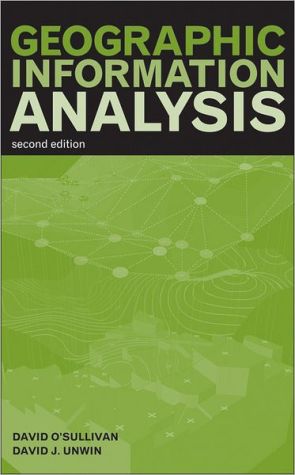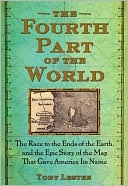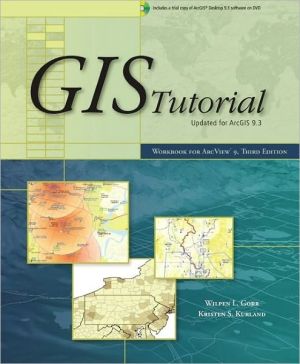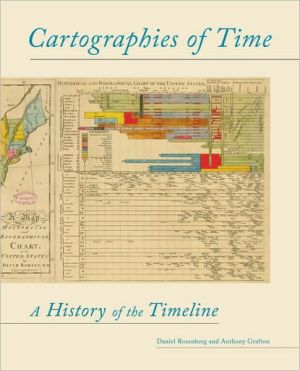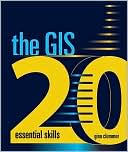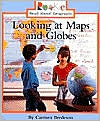Geographic Information Analysis
Clear, up-to-date coverage of methods for analyzing geographical information in a GIS context\ Geographic Information Analysis, Second Edition is fully updated to keep pace with the most recent developments of spatial analysis in a geographic information systems (GIS) environment. Still focusing on the universal aspects of this science, this revised edition includes new coverage on geovisualization and mapping as well as recent developments using local statistics.\ Building on the...
Search in google:
Clear, up-to-date coverage of methods for analyzing geographical information in a GIS context Geographic Information Analysis, Second Edition is fully updated to keep pace with the most recent developments of spatial analysis in a geographic information systems (GIS) environment. Still focusing on the universal aspects of this science, this revised edition includes new coverage on geovisualization and mapping as well as recent developments using local statistics. Building on the fundamentals, this book explores such key concepts as spatial processes, point patterns, and autocorrelation in area data, as well as in continuous fields. Also addressed are methods for combining maps and performing computationally intensive analysis. New chapters tackle mapping, geovisualization, and local statistics, including the Moran Scatterplot and Geographically Weighted Regression (GWR). An appendix provides a primer on linear algebra using matrices. Complete with chapter objectives, summaries, "thought exercises," explanatory diagrams, and a chapter-by-chapter bibliography, Geographic Information Analysis is a practical book for students, as well as a valuable resource for researchers and professionals in the industry.
Geographic Information Analysis\ \ By David O'Sullivan David Unwin \ John Wiley & Sons\ ISBN: 0-471-21176-1 \ \ \ Chapter One\ Geographic Information Analysis and Spatial Data\ CHAPTER OBJECTIVES\ In this first chapter, we:\ Define geographic information analysis (or spatial analysis) as it is meant in this book\ Distinguish geographic information analysis from GIS-based spatial analysis operations while relating the two\ Review the entity-attribute model of spatial data as consisting of points, lines, areas, and fields, with associated nominal, ordinal, interval, or ratio data\ Review GIS spatial manipulation operations and emphasize their importance\ After reading this chapter, you should be able to:\ List three different approaches to spatial analysis and differentiate between them\ Distinguish between spatial objects and spatial fields and say why the vector versus raster debate in GIS is really about how we choose to represent these entity types\ Differentiate between point, line, and area objects and give examples of each\ Differentiate between nominal, ordinal, interval, and ratio attribute data and give examples of each\ Give examples of at least 12 resulting types of spatial data\ List some of the basic geometrical analyses available in a typical GIS\ Give reasons why modern methods of spatial analysis are not well represented in the tool kits provided by a typical GIS\ 1.1. INTRODUCTION\ Geographic information analysis is not an established discipline. In fact, it is a rather new concept. To define what we mean by this term, it is necessary first to define a much older term-spatial analysis-and then to describe how we see the relationship between the two. Of course, a succinct definition of spatial analysis is not straightforward either. The term comes up in various contexts. At least four broad areas are identifiable in the literature, each using the term in different ways:\ 1. Spatial data manipulation, usually in a geographic information system (GIS), is often referred to as spatial analysis, particularly in GIS companies' promotional material. Your GIS manuals will give you a good sense of the scope of these techniques, as will texts by Tomlin (1990) and, more recently, Mitchell (1999).\ 2. Spatial data analysis is descriptive and exploratory. These are important first steps in all spatial analysis, and often all that can be done with very large and complex data sets. Books by geographers such as Unwin (1981), Bailey and Gatrell (1995), and Fotheringham et al. (2000) are very much in this tradition.\ 3. Spatial statistical analysis employs statistical methods to interrogate spatial data to determine whether or not the data are "typical" or "unexpected" relative to a statistical model. The geography texts cited above touch on these issues, and there are a small number of texts by statisticians interested in the analysis of spatial data, notably those by Ripley (1981, 1988), Diggle (1983), and Cressie (1991).\ 4. Spatial modeling involves constructing models to predict spatial outcomes. In human geography, models are used to predict flows of people and goods between places or to optimize the location of facilities (Wilson, 1974, 2000), whereas in environmental science, models may attempt to simulate the dynamics of natural processes (Ford, 1999). Modeling techniques are a natural extension to spatial analysis, but most are beyond the scope of this book.\ In practice, it is often difficult to distinguish among these approaches, and most serious quantitative research or investigation in geography and allied disciplines may involve all four. Data are stored and visualized in a GIS environment, and descriptive and exploratory techniques may raise questions and suggest theories about the phenomena of interest. These theories may be subjected to traditional statistical testing using spatial statistical techniques. Theories of what is going on may be the basis for computer models of the phenomena, and their results may in turn be subjected to statistical investigation and analysis.\ Current GISs typically include item 1 as standard (a GIS without these functions would be just a plain old IS!) and have some simple data analysis capabilities, especially exploratory analysis using maps (item 2). GISs only rarely incorporate the statistical methods of item 3 and almost never include the capability to build spatial models and determine their probable outcomes. Items 2, 3, and 4 are closely interrelated and are distinguished here just to emphasize that statistics (item 3) is about assessing probability and assigning confidence to parameter estimates of populations, not simply about calculating summary measures such as the sample mean. In this book we focus most on items 2 and 3. In practice, you will find that statistical testing of spatial data is relatively rare. Statistical methods are well worked out and understood for some types of spatial data, but less so for many others. As this book unfolds, you should begin to understand why this is so.\ Despite this focus, don't underestimate the importance of the spatial data manipulation functions provided by a GIS, such as buffering, point-in-polygon queries, and so on. These are an essential precursor to generating questions and formulating hypotheses. We review these topics in Section 1.3, to reinforce their importance and to consider how they might benefit from a more statistical approach. More generally, the way that spatial data are stored-or how geographical phenomena are represented in a GIS-is increasingly important for subsequent analysis. We therefore spend some time on this issue in most chapters of the book. This is why we use the broader term geographic information analysis for the material we cover. A working definition of geographic information analysis is that it is concerned with investigating the patterns that arise as a result of processes that may be operating in space. Techniques and methods to enable the representation, description, measurement, comparison, and generation of spatial patterns are central to the study of geographic information analysis.\ For now we will stick with whatever intuitive notion you have about the meaning of two key terms here: pattern and process. As we work through the concepts of point pattern analysis in Chapters 3 and 4, it will become clearer what is meant by both terms. For now, we will concentrate on the question of the general spatial data types you can expect to encounter in studying geography.\ When you think of the world in map form, how do you view it? In the early GIS literature a distinction was often made between two kinds of system, characterized by the way that geography was represented in digital form:\ 1. A vector view, which records locational coordinates of the points, lines, and areas that make up a map. In the vector view we list the features present on a map and represent each as a point, line, or area object. Such systems had their origins in the use of computers to draw maps based on digital data and were particularly valued when computer memory was an expensive commodity. Although the fit is inexact, the vector model conforms to an object view of the world, where space is thought of as an empty container occupied by different sorts of objects.\ 2. Contrasted with vector systems were raster systems. Instead of starting with objects on the ground, a grid of small units of Earth's surface (called pixels) is defined. For each pixel, the value, or presence or absence of something of interest, is then recorded. Thus, we divide a map into a set of identical, discrete elements and list the contents of each. Because everywhere in space has a value (even if this is a zero or null), the raster approach is usually less economical of computer memory than is the vector system. Raster systems originated mostly in image processing, where data from remote sensing platforms are often encountered.\ In this section we hope to convince you that at a higher level of abstraction, the vector-raster distinction is not very useful and that it obscures a more important division between what we call an object and a field view of the world.\ The Object View\ In the object view, we consider the world as a series of entities located in space. Entities are (usually) real: You can touch them, stand in them, perhaps even move them around. An object is a digital representation of all or part of an entity. Objects may be classified into different object types: for example, into point objects, line objects, and area objects. In specific applications these types are instantiated by specific objects. For example, in an environmental GIS, woods and fields might be instances of area objects. In the object view of the world, places can be occupied by any number of objects. A house can exist in a census tract, which may also contain lampposts, bus stops, road segments, parks, and so on.\ Different object types may represent the same real-world entities at different scales. For example, on his daily journey to work, one of us arrives in London by rail at an object called Euston Station. At one scale this is a dot on the map, a point object. Zoom in a little and Euston Station becomes an area object. Zooming in closer still, we see a network of railway lines (a set of line objects) together with some buildings (area objects). Clearly, the same entity may be represented in several ways. This is an example of the multiple-representation problem.\ Because we can associate behavior with objects, the object view has advantages when well-defined objects change in time: for example, the changing data for a census area object over a series of population censuses. Life is not so simple if the objects are poorly defined (fuzzy objects), have uncertain boundaries, or change their boundaries over time. Note that we have said nothing about object orientation in the computer science sense. Worboys et al. (1990) give a straightforward description of this concept as it relates to spatial data.\ The Field View\ In the field view, the world is made up of properties varying continuously across space. An example is the surface of Earth itself, where the field variable is the height above sea level (the elevation). Similarly, we can code the ground in a grid cell as either having a house on it or not. The result is also a field, in this case of binary numbers where 1 = house and 0 = no house. If it is large enough or if its outline crosses a grid cell boundary, a single house may be recorded as being in more than one grid cell. The key factors here are spatial continuity and self-definition. In a field, everywhere has a value (including "not here" or zero), and sets of values taken together define the field. In the object view it is necessary to attach further attributes to represent an object fully-a rectangle is just a rectangle until we attach descriptive attributes to it.\ You should note that the raster data model is just one way to record a field. In a raster model the geographic variation of the field is represented by identical, regularly shaped pixels. An alternative is to use area objects in the form of a mesh of nonoverlapping triangles, called a triangulated irregular network (TIN) to represent field variables. In a TIN each triangle vertex is assigned the value of the field at that location. In the early days of GISs, especially in cartographic applications, values of the land elevation field were recorded using digital representations of the contours familiar from topographic maps. This is a representation of a field using overlapping area objects, the areas being the parts of the landscape enclosed within each contour.\ Finally, another type of field is one made up of a continuous cover of assignments for a categorical variable. Every location has a value, but values are simply the names given to phenomena. A good example is a map of soil type. Everywhere has a soil, so we have spatial continuity, and we also have self-definition by the soil type involved, so this is a field view. Other examples might be a land-use map, even a simple map of areas suitable or unsuitable for some development. In the literature, these types of field variables have been given many different names. Quantitative geographers used to call them k-color maps on the grounds that to show them as maps the usual way was to assign a color to each type to be represented and that a number of colors (k) would be required, depending on the variable. When there are just two colors, call them black (1) and white (0), this gives a binary map. A term that is gaining ground is categorical coverage, to indicate that we have a field made up of a categorical variable.\ For a categorical coverage, whether we think of it as a collection of objects or as a field is entirely arbitrary, an artifact of how we choose to record and store it. On the one hand, we can adopt the logic discussed above to consider the entities as field variables. On the other, why don't we simply regard each patch of color (e.g., the outcrops of a specified rock type or soil type) as an area object in an object view of the world? In the classic georelational data structure employed by early versions of ArcInfo, this is exactly how such data were recorded and stored, with the additional restriction that the set of polygonal area objects should fit together without overlaps or gaps, a property known as planar enforcement. So is a planar-enforced categorical coverage in a GIS database an object or a field representation of the real world? We leave you to decide but also ask you to consider whether or not it really matters.\ Choosing the Representation to Be Used\ In practice, it is useful to get accustomed to thinking of the elements of reality modeled in a GIS database as having two types of existence. First, there is the element in reality, which we call the entity. Second, there is the element as it is represented in the database. In database theory, this is called the object (confusingly, this means that a field is a type of object).\ \ Continues...\ \ \ \ Excerpted from Geographic Information Analysis by David O'Sullivan David Unwin Excerpted by permission.\ All rights reserved. No part of this excerpt may be reproduced or reprinted without permission in writing from the publisher.\ Excerpts are provided by Dial-A-Book Inc. solely for the personal use of visitors to this web site. \ \
Preface1Geographic Information Analysis and Spatial Data12The Pitfalls and Potential of Spatial Data263Fundamentals: Maps as Outcomes of Processes514Point Pattern Analysis775Practical Point Pattern Analysis1156Lines and Networks1357Area Objects and Spatial Autocorrelation1678Describing and Analyzing Fields2099Knowing the Unknowable: The Statistics of Fields24610Putting Maps Together: Map Overlay28411Multivariate Data, Multidimensional Space, and Spatialization31512New Approaches to Spatial Analysis356A: The Elements of Statistics384B: Matrices and Matrix Mathematics412Index431
\ From the Publisher“This text provides a well organized introduction to the fundamental concepts of spatial analysis for GIS students.” (GISWeekly, 13 December 2012)\ \ \
